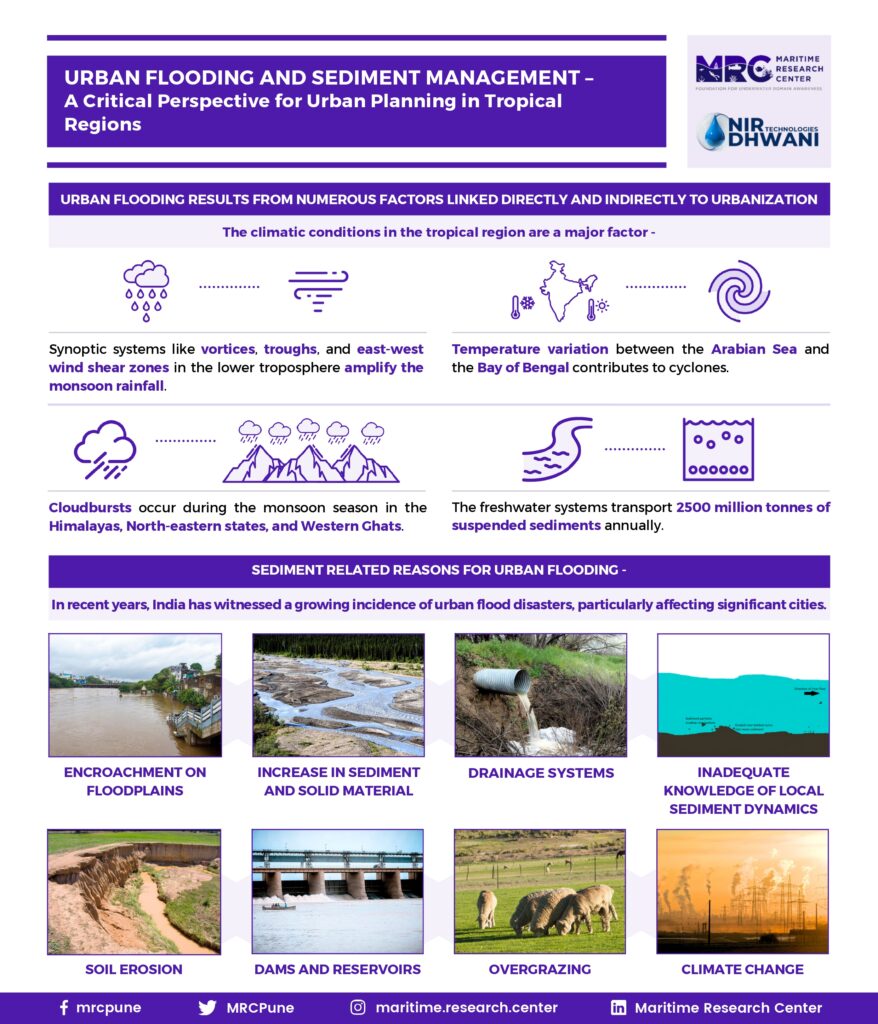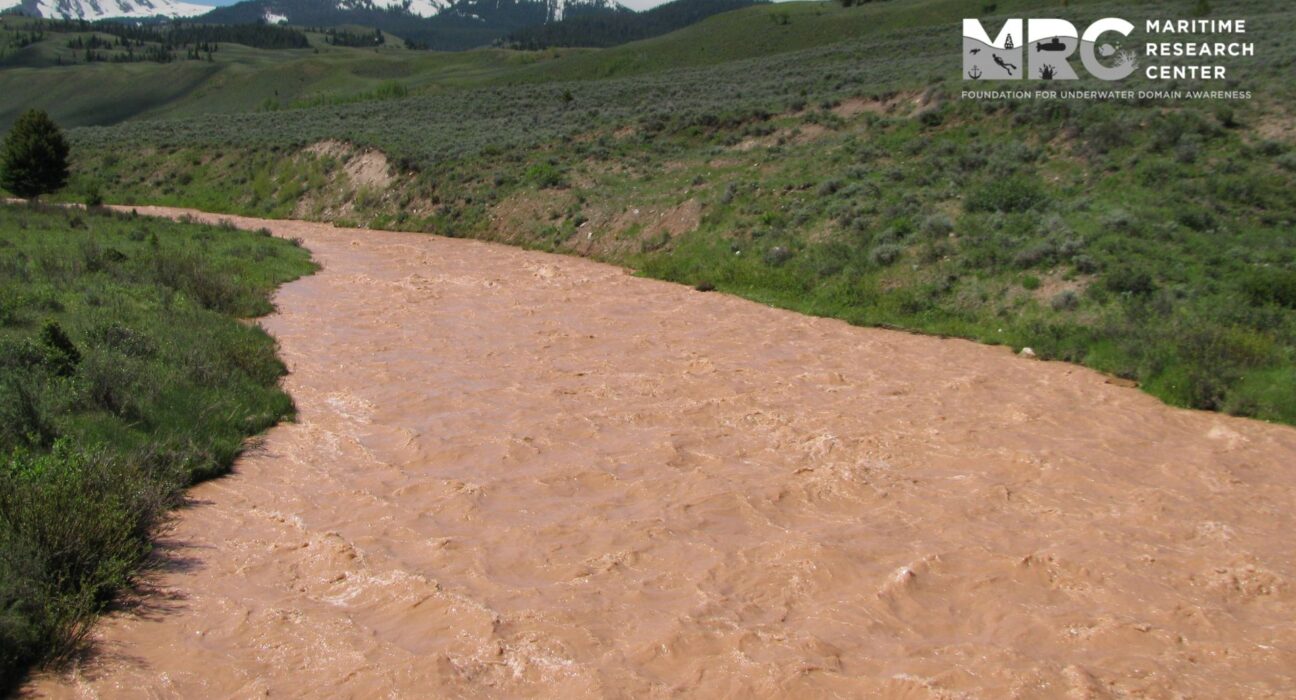- Urban flooding has become a serious menace across multiple urban centers in the country.
- Global climate change alters weather patterns, leading to more frequent high-intensity rainfall events within shorter durations.
- Due to the unique characteristics of tropical regions, specialised strategies are necessary for managing urban flooding and related issues.
- A significant factor contributing to urban flooding in Indian cities is the insufficient drainage infrastructure.
- While large-scale dams limit nutrient deposition through seasonal flooding, they protect riverside settlements from severe floods.
Election times are here now and the silent citizens have a chance to voice their concerns. Urbanization is a sign of prosperity in the conventional sense and more and more aspirational middle class are moving towards the urban centers to be counted with their fellow dwellers. This socio-economic trend is very hard to regulate, but this will lead to serious socio-cultural and socio-political catastrophe. Every trend must be understood and managed in all its dimensions. India saw a massive urbanization trend post the liberalization in 1991. The doors were opened, not just to the western Multi-National Companies (MNCs), but also to the western ideas across multiple dimensions. The traditional wisdom of over 10,000 years of civilizational legacy, was replaced with western centric concepts. Urban planning also went the western ways. One serious aspect is the tropical conditions, that we live in. However, the unique tropical characteristics, get completely overlooked in our policy making and strategic discourse. As climate change triggered extreme events, this is only going to get worse. The government is also looking at massive investments in creating urban centers with so-called modern infrastructure, however the recurring natural disasters are becoming a serious threat to such big-ticket investments.
The climatic conditions in the tropical region are a major factor. The primary rainy season occurs during the southwest monsoon from June to September in the North and the northeast monsoon from October onwards, in the South, contributing to 70-75% annual rainfall. Within the monsoon system, additional synoptic systems like vortices (low-pressure areas, depressions, and cyclones), troughs, and east-west wind shear zones in the lower troposphere significantly amplify the monsoon rainfall. The significant temperature variation between the Arabian Sea and the Bay of Bengal, characterised by varying salinity and temperature due to river runoff, contributes to cyclones. Additionally, cloudbursts along with rapid and heavy localised rainfall events occur during the monsoon season in orographically dominant regions like India’s Himalayas, North-eastern states, and Western Ghats
Socio-Economic Characteristics
Presently, approximately 40% of the global population resides in tropical regions. Beyond rapid population growth, the region is witnessing an increase in affluence as more people escape poverty. This growth, coupled with expansive agriculture, occurs in an area rich in biodiversity and endemism. In tropical regions, the absence of frost and continuous heat enables life and reproduction year-round, as the usual limiting factor of winter is non-existent. The constant conditions facilitate diverse life forms, including plants, insects, birds, microbes, animals, and crops. However, fierce competition ensues, leading to only a select few individuals of each species surviving in any given location.
Due to the unique characteristics of tropical regions, specialised strategies are necessary for managing urban flooding and related issues. However, as noted by Celso Furtado in 1963, existing technology is predominantly designed for temperate climates, making it challenging to adapt readily to the tropics with their distinct set of resources. Kenneth Boulding also emphasised that development, like economics, has primarily been tailored to Temperate Zone environments. Imposing techniques developed for temperate zones in the tropics, whether in engineering, agriculture, or economics, can lead to disastrous outcomes.
Sediment-Related Reasons for Urban Flooding
In recent years, India has witnessed a growing incidence of urban flood disasters, particularly affecting significant cities.

Encroachment on Floodplains
Government agencies and experts attribute the rising frequency and damages from floods in India to encroachments in the floodplains of rivers. A 2018 Comptroller and Auditor General of India (CAG) report pointed to encroachments in Tamil Nadu’s river floodplains as a critical factor in the 2015 Chennai floods. Large settlements are emerging in low-lying zones in urban areas, often encroaching on drainage channels, with houses constructed over nullahs and drains.
Increase in Sediment and Solid Material
Urban development significantly amplifies sediment production within the watershed due to construction activities, land clearing for housing, and the creation of streets, avenues, and highways. Surface erosion results in the degradation of areas, forming substantial ravines, particularly in fragile soils, with depths of up to 30 m and widths of 50 m. Urbanisation often increases impervious surfaces like roads, parking lots, and buildings, hindering water infiltration into the soil and causing more runoff. Sediment erosion from construction sites or denuded landscapes further contributes to sedimentation in water bodies, exacerbating the risk of flooding.
During a flood, the accumulation of waste and debris from floodwaters can lead to heightened property damage. After the flood, deposited waste obstructs access, posing toxin threats and creating a breeding ground for diseases. Intense rainfall overwhelms sewer and storm drain capacities, with plastic blockages identified as the leading cause of the devastating 2005 Mumbai floods.
Drainage Systems
A significant factor contributing to urban flooding in Indian cities is the insufficient drainage infrastructure. Many urban areas lack adequately designed stormwater drainage systems capable of managing intense rainfall. Rapid city expansion without proper planning results in impervious surfaces such as roads and buildings, hindering water absorption into the ground and overwhelming inadequate drainage systems. The concretisation of drains exacerbates flooding by preventing water percolation into the ground.
Clogs in drainage channels diminish the discharge capacity of urban conduits, rivers, and lakes. Sediments on various urban surfaces enter the drainage system, carrying pollutants contaminating stormwater. Obstructions like bridge backfilling, piles, inadequate drains, and clogged conduits can impede runoff. In developing countries with more sediment and weaker urban management, sediment in the drainage system significantly affects its performance. Poor operational practices, mainly neglecting clearing drains from the outlet end in minor drains, result in minimal net benefits.
Inadequate Knowledge of Local Sediment Dynamics
Frequent evaluations of sediment transport, deposition, loads, erosion rates, and water quality are crucial in effective watershed and sediment management. Given the dynamic nature of watersheds, an adaptive management approach is vital, allowing for the responsive handling of evolving conditions, emerging challenges, and potential impacts of climate change.
Regrettably, research on suspended sediment, particularly in Eastern Himalayan rivers, faces limitations due to an inadequate gauge network, restricted data availability in the public domain, and hydrological disruptions caused by dam construction or extreme hydrometeorological events. The challenge lies in obtaining comprehensive and current sediment dynamics data in India. Some areas lack monitoring infrastructure, such as sediment gauging stations and equipment, making accurate and continuous data collection difficult.
Soil Erosion
Approximately 53% of India’s land area experiences soil runoff, with high erosion affecting areas along the Yamuna, Chambal, Mahi, and other west-flowing rivers in western states. The Himalayan and lower Himalayan regions face more severe erosion due to activities like heavy tree cutting, road construction, mining, and farming on steep slopes. Major river areas frequently encounter massive floods and transport substantial sediment. The Kosi River creates a significant yet unstable alluvial fan composed of sand. Research on suspended sediment movement in Himalayan rivers indicates that mountain-flowing rivers carry more sediment than those flowing from slopes or plains.
Eroded soil particles, transported by runoff, can reach stormwater drains, rivers, and other water bodies. Sediment accumulation in drainage channels reduces capacity, heightening flood risks during heavy rainfall.
Dams and Reservoirs
Dams and reservoirs, vital for water storage and hydropower, face a risk of sedimentation. The sediment budget’s significant outcome is the reservoirs in the catchment exhibiting high simulated sediment trapping efficiency. The Central Water Commission (CWC) of India acknowledges the economic impact, estimating an annual 1.5% reduction in reservoir storage capacity due to sediment accumulation. Activities like dam construction, river flow redirection, and resource extraction can result in coastal erosion, subsidence, and changes in the freshwater-saltwater interface. While large-scale dams limit nutrient deposition through seasonal flooding, they protect riverside settlements from severe floods. However, increased sediment deposition can contribute to more flooding, causing various issues such as property damage, water contamination, crop loss, social upheaval, temporary displacement, and even loss of life.
Many cities and towns, both small and large, are situated along the banks of rivers. Floods in these rivers result in the flooding of the adjacent floodplains, exacerbated by urban expansion into these areas, limiting natural overflow space. Some cities are positioned downstream or upstream of dams and reservoirs. Those downstream can face flooding due to excess water releases. Additionally, cities upstream of dams may be affected by rising backwater levels if water release is unexpectedly withheld during flood seasons. Instances of sudden, unnotified water releases have led to significant loss of life and property.
Overgrazing
Excessive grazing by livestock can deplete vegetation cover, including grasses and other plants, which is crucial for stabilising soil and preventing erosion. The absence of vegetation makes the soil more vulnerable to erosion. Healthy vegetation enhances soil permeability, facilitating water infiltration into the ground. Overgrazing, however, can compact the soil, reducing its capacity to absorb water and increasing surface runoff during rainfall. Livestock grazing on river banks, farming on treeless steep slopes, and lacking riparian vegetation contribute to high sediment levels in waterways. These areas become unstable over time, prone to slips and erosion, especially during floods. Reduced vegetation and compacted soil increase the likelihood of rainwater flowing over the surface rather than being absorbed.
Climate Change
The prevailing belief is that global warming will continuously increase extreme rainfall events, significantly impacting flood risk worldwide. According to the recent Intergovernmental Panel on Climate Change (IPCC) special report, global warming may reach 1.5 °C between 2030 and 2052. This warming is expected to increase the intensity and frequency of extreme precipitation. Large cities with intricate drainage networks are increasingly challenged by rising flood volumes, posing infrastructure failure risks, property damage, and potential loss of life.
Thus, it is critical to appreciate the sediment transport pattern for the site-specific local characteristics to be able to manage the urban flooding crisis, turning to monstrous proportions. Sediment management in tropical waters has to be prioritized across varied dimensions.

Dr. (Cdr) Arnab Das , Romit R. Kaware
About Author
Dr. (Cdr) Arnab Das, Director and Founder of MRC, Pune. Dr Das is an ex Naval officer with 2 decades of active services and PhD holder from IIT Delhi with specialization in Underwater Acoustics. He has worked on several projects and has a plethora of publications to his credit.
Romit Rajendra Kaware is a recent graduate from the Indian Institute of Technology (IIT) Delhi, holding a Bachelor’s degree in Civil Engineering. Currently, he is serving as a research fellow at MRC. His primary focus during his fellowship is on scientific research in structures and materials, as it enhances comprehension of the methodologies employed in constructing resilient infrastructure. Romit is deeply enthusiastic about applying his expertise in civil engineering to the maritime sector to foster sustainable development for our ecological resources.


